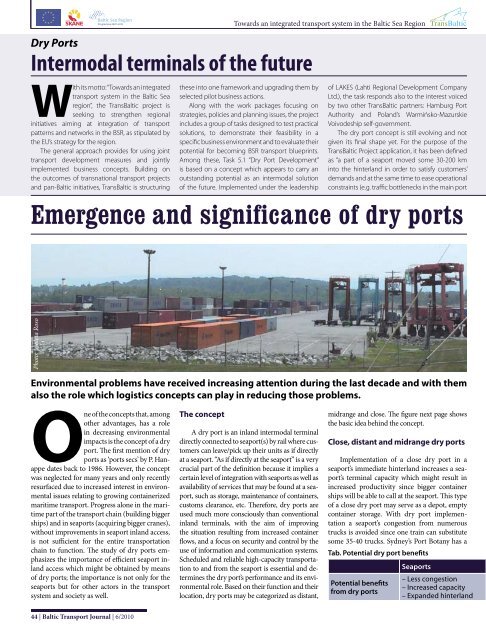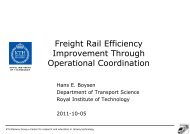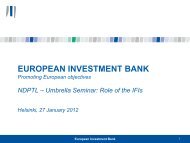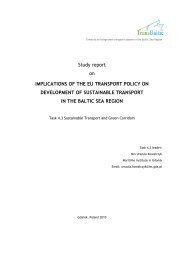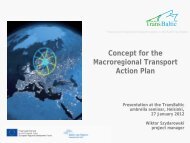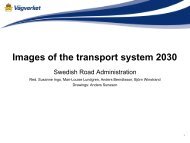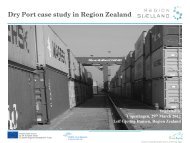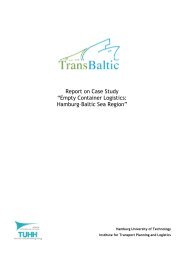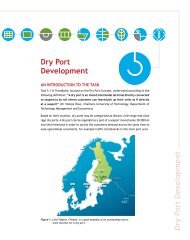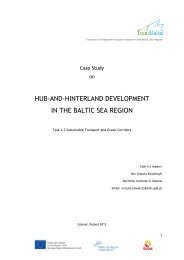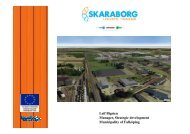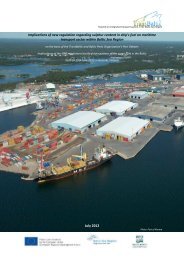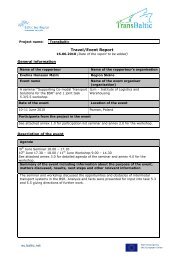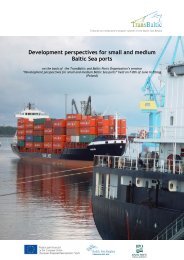Emergence and significance of dry ports Intermodal ... - TransBaltic
Emergence and significance of dry ports Intermodal ... - TransBaltic
Emergence and significance of dry ports Intermodal ... - TransBaltic
You also want an ePaper? Increase the reach of your titles
YUMPU automatically turns print PDFs into web optimized ePapers that Google loves.
Dry Ports<br />
<strong>Intermodal</strong> terminals <strong>of</strong> the future<br />
With its motto: “Towards an integrated<br />
transport system in the Baltic Sea<br />
region”, the <strong>TransBaltic</strong> project is<br />
seeking to strengthen regional<br />
initiatives aiming at integration <strong>of</strong> transport<br />
patterns <strong>and</strong> networks in the BSR, as stipulated by<br />
the EU’s strategy for the region.<br />
The general approach provides for using joint<br />
transport development measures <strong>and</strong> jointly<br />
implemented business concepts. Building on<br />
the outcomes <strong>of</strong> transnational transport projects<br />
<strong>and</strong> pan-Baltic initiatives, <strong>TransBaltic</strong> is structuring<br />
Towards an integrated transport system in the Baltic Sea Region<br />
these into one framework <strong>and</strong> upgrading them by<br />
selected pilot business actions.<br />
Along with the work packages focusing on<br />
strategies, policies <strong>and</strong> planning issues, the project<br />
includes a group <strong>of</strong> tasks designed to test practical<br />
solutions, to demonstrate their feasibility in a<br />
specific business environment <strong>and</strong> to evaluate their<br />
potential for becoming BSR transport blueprints.<br />
Among these, Task 5.1 “Dry Port Development”<br />
is based on a concept which appears to carry an<br />
outst<strong>and</strong>ing potential as an intermodal solution<br />
<strong>of</strong> the future. Implemented under the leadership<br />
<strong>of</strong> LAKES (Lahti Regional Development Company<br />
Ltd.), the task responds also to the interest voiced<br />
by two other <strong>TransBaltic</strong> partners: Hamburg Port<br />
Authority <strong>and</strong> Pol<strong>and</strong>’s Warmińsko-Mazurskie<br />
Voivodeship self-government.<br />
The <strong>dry</strong> port concept is still evolving <strong>and</strong> not<br />
given its final shape yet. For the purpose <strong>of</strong> the<br />
<strong>TransBaltic</strong> Project application, it has been defined<br />
as “a part <strong>of</strong> a seaport moved some 30-200 km<br />
into the hinterl<strong>and</strong> in order to satisfy customers’<br />
dem<strong>and</strong>s <strong>and</strong> at the same time to ease operational<br />
constraints (e.g. traffic bottlenecks in the main port<br />
<strong>Emergence</strong> <strong>and</strong> <strong>significance</strong> <strong>of</strong> <strong>dry</strong> <strong>ports</strong><br />
Photo: Violeta Roso<br />
Environmental problems have received increasing attention during the last decade <strong>and</strong> with them<br />
also the role which logistics concepts can play in reducing those problems.<br />
One <strong>of</strong> the concepts that, among<br />
other advantages, has a role<br />
in decreasing environmental<br />
impacts is the concept <strong>of</strong> a <strong>dry</strong><br />
port. The first mention <strong>of</strong> <strong>dry</strong><br />
<strong>ports</strong> as ‘<strong>ports</strong> secs’ by P. Hanappe<br />
dates back to 1986. However, the concept<br />
was neglected for many years <strong>and</strong> only recently<br />
resurfaced due to increased interest in environmental<br />
issues relating to growing containerized<br />
maritime transport. Progress alone in the maritime<br />
part <strong>of</strong> the transport chain (building bigger<br />
ships) <strong>and</strong> in sea<strong>ports</strong> (acquiring bigger cranes),<br />
without improvements in seaport inl<strong>and</strong> access,<br />
is not sufficient for the entire transportation<br />
chain to function. The study <strong>of</strong> <strong>dry</strong> <strong>ports</strong> emphasizes<br />
the importance <strong>of</strong> efficient seaport inl<strong>and</strong><br />
access which might be obtained by means<br />
<strong>of</strong> <strong>dry</strong> <strong>ports</strong>; the importance is not only for the<br />
sea<strong>ports</strong> but for other actors in the transport<br />
system <strong>and</strong> society as well.<br />
The concept<br />
A <strong>dry</strong> port is an inl<strong>and</strong> intermodal terminal<br />
directly connected to seaport(s) by rail where customers<br />
can leave/pick up their units as if directly<br />
at a seaport. “As if directly at the seaport” is a very<br />
crucial part <strong>of</strong> the definition because it implies a<br />
certain level <strong>of</strong> integration with sea<strong>ports</strong> as well as<br />
availability <strong>of</strong> services that may be found at a seaport,<br />
such as storage, maintenance <strong>of</strong> containers,<br />
customs clearance, etc. Therefore, <strong>dry</strong> <strong>ports</strong> are<br />
used much more consciously than conventional<br />
inl<strong>and</strong> terminals, with the aim <strong>of</strong> improving<br />
the situation resulting from increased container<br />
flows, <strong>and</strong> a focus on security <strong>and</strong> control by the<br />
use <strong>of</strong> information <strong>and</strong> communication systems.<br />
Scheduled <strong>and</strong> reliable high-capacity transportation<br />
to <strong>and</strong> from the seaport is essential <strong>and</strong> determines<br />
the <strong>dry</strong> port’s performance <strong>and</strong> its environmental<br />
role. Based on their function <strong>and</strong> their<br />
location, <strong>dry</strong> <strong>ports</strong> may be categorized as distant,<br />
midrange <strong>and</strong> close. The figure next page shows<br />
the basic idea behind the concept.<br />
Close, distant <strong>and</strong> midrange <strong>dry</strong> <strong>ports</strong><br />
Implementation <strong>of</strong> a close <strong>dry</strong> port in a<br />
seaport’s immediate hinterl<strong>and</strong> increases a seaport’s<br />
terminal capacity which might result in<br />
increased productivity since bigger container<br />
ships will be able to call at the seaport. This type<br />
<strong>of</strong> a close <strong>dry</strong> port may serve as a depot, empty<br />
container storage. With <strong>dry</strong> port implementation<br />
a seaport’s congestion from numerous<br />
trucks is avoided since one train can substitute<br />
some 35-40 trucks. Sydney’s Port Botany has a<br />
Tab. Potential <strong>dry</strong> port benefits<br />
Potential benefits<br />
from <strong>dry</strong> <strong>ports</strong><br />
Sea<strong>ports</strong><br />
– Less congestion<br />
– Increased capacity<br />
– Exp<strong>and</strong>ed hinterl<strong>and</strong><br />
44 | Baltic Transport Journal | 6/2010
Towards an integrated transport system in the Baltic Sea Region<br />
area)”. Task 5.1 Leader proposes the Project Partners<br />
to accept the definition worded by Dr Violeta<br />
Roso: “The <strong>dry</strong> port concept is based on a seaport<br />
directly connected by rail to inl<strong>and</strong> intermodal<br />
terminals, where shippers can leave <strong>and</strong>/or collect<br />
their goods in intermodal loading units as if directly<br />
at a seaport.”<br />
Dry <strong>ports</strong> seem to be particularly attractive<br />
in the Baltic context, with its extremely intensive<br />
traffic within much limited space, with all the<br />
problems this fact is bringing about: constrained<br />
road access, long queuing times, <strong>and</strong> a low share <strong>of</strong><br />
rail transport mode in cargo supply. Moving some<br />
<strong>of</strong> the traditional port-related services from the<br />
seaport to the hinterl<strong>and</strong> solves various problems<br />
– not only those <strong>of</strong> a strictly operational or logistic<br />
nature. Reduction <strong>of</strong> concentrated greenhouse gas<br />
emissions, stimulation <strong>of</strong> the hinterl<strong>and</strong>’s business<br />
competitiveness <strong>and</strong> generating new employment<br />
opportunities are just those most important to be<br />
mentioned.<br />
<strong>TransBaltic</strong> Project Task 5.1 will demonstrate<br />
how the <strong>dry</strong> port concept can contribute to<br />
the cohesion <strong>and</strong> co-modality objectives <strong>of</strong> EU<br />
transport <strong>and</strong> regional policies; therefore, <strong>dry</strong><br />
<strong>ports</strong> can be seen as components <strong>of</strong> the future<br />
Trans-European Transport Network (TEN-T) to be<br />
established as a key element in the revised Lisbon<br />
strategy. Considering TEN-T’s primary focus to fill<br />
the gaps <strong>and</strong> eliminate bottlenecks in European<br />
transport infrastructure, as well as to ensure the<br />
sustainability <strong>of</strong> the transport networks, the <strong>dry</strong><br />
<strong>ports</strong> concept is clearly a perfect answer to many<br />
<strong>of</strong> the challenges involved.<br />
The <strong>dry</strong>port – a development worked upon in<br />
<strong>TransBaltic</strong> project is a good example on how both<br />
knowledge transfer <strong>and</strong> crossover <strong>of</strong> results can be<br />
achieved between other ongoing <strong>and</strong> previous<br />
projects. In this case, this has been SustAccess, a<br />
project completed in 2006, where the <strong>dry</strong>port issue<br />
was introduced as an Interreg North Sea Programme<br />
important development <strong>and</strong> the ongoing „Dryport<br />
– a Modal Shift in Practice”, both these projects with<br />
Region Västra Götal<strong>and</strong> as a lead partner.<br />
Having introduced the <strong>dry</strong> <strong>ports</strong> concept as a<br />
component <strong>of</strong> the <strong>TransBaltic</strong> project, let us now<br />
get a deeper insight into how this innovative<br />
solution is expected to work in practice, as an<br />
element <strong>of</strong> the freight transport chain. <br />
Małgorzata Nosorowska<br />
Fig. The concept <strong>of</strong> a <strong>dry</strong> port.<br />
a) 1<br />
b)<br />
a) b)<br />
i<br />
i<br />
1<br />
2<br />
2<br />
5<br />
5<br />
4<br />
4<br />
3<br />
3<br />
1<br />
1<br />
i<br />
i<br />
1<br />
1<br />
i<br />
i<br />
Shippers<br />
Shippers<br />
Seaport<br />
Seaport<br />
Road<br />
Road<br />
City<br />
City<br />
Dry port<br />
Dry port<br />
Shippers<br />
Shippers<br />
Seaport<br />
Seaport<br />
Road<br />
Road<br />
Rail<br />
Rail<br />
City<br />
City<br />
network <strong>of</strong> intermodal terminal facilities some since all 30,000 TEU h<strong>and</strong>led there come<br />
<strong>of</strong> which play the role <strong>of</strong> a close <strong>dry</strong> port. MIST from newly acquired customers for the Virginia<br />
terminal in Minto, 45 km from Port Botany, is<br />
port. There is a high level <strong>of</strong> integration<br />
an intermodal precinct with daily rail shuttles between the seaport <strong>and</strong> the <strong>dry</strong> port. It was<br />
to the seaport, h<strong>and</strong>ling 40,000 TEU/year <strong>and</strong> the Virginia Port Authority which initiated the<br />
generating benefits not only for the operator but expansion into the 330 km distant hinterl<strong>and</strong>,<br />
for the seaport <strong>and</strong> society as well.<br />
i.e. extended the seaport’s interface through<br />
The benefits <strong>of</strong> distant <strong>dry</strong> <strong>ports</strong> derive the <strong>dry</strong> port. VIP is considered a US customs<br />
from the modal shift from road to rail, resulting<br />
designated port <strong>of</strong> entry where a full range <strong>of</strong><br />
in reduced congestion at seaport gates <strong>and</strong> customs services is available for its customers.<br />
their surroundings as well as reduced external A midrange <strong>dry</strong> port is situated within a distance<br />
environmental effects along the route. A reduced<br />
from the seaport generally covered by road<br />
number <strong>of</strong> lorries on the roads brings transport <strong>and</strong> serves as a consolidation point<br />
down congestion, accidents <strong>and</strong> road maintenance<br />
for different rail services. The high frequency<br />
costs as well. The distant <strong>dry</strong> port<br />
extends the gates <strong>of</strong> the seaport inl<strong>and</strong>, with<br />
shippers viewing the <strong>dry</strong> port as an interface to<br />
the seaport <strong>and</strong> shipping lines. In other words<br />
the distant <strong>dry</strong> port improves seaport access to<br />
areas outside its traditional hinterl<strong>and</strong>, i.e. extends<br />
the seaport’s hinterl<strong>and</strong> <strong>and</strong> attracts new<br />
customers. Virginia Inl<strong>and</strong> Port (VIP) is an<br />
excellent example <strong>of</strong> extending a seaport’s hinterl<strong>and</strong><br />
<strong>and</strong> bringing competitive advantage<br />
i<br />
i<br />
1<br />
1<br />
2<br />
2<br />
5<br />
5<br />
4<br />
4<br />
3<br />
3<br />
achieved by consolidating flows, together with<br />
the relatively short distance, facilitates the loading<br />
<strong>of</strong> containers for one container vessel in the<br />
dedicated trains. Falköping <strong>dry</strong> port is situated<br />
130 km from the Port <strong>of</strong> Gothenburg on the rail<br />
junction to the network <strong>of</strong> inl<strong>and</strong> terminals <strong>and</strong><br />
as such is an excellent consolidation point. The<br />
facility is undergoing major development <strong>and</strong><br />
soon, apart from accommodating bigger trains,<br />
5/2009 | Baltic Transport Journal | 3<br />
will <strong>of</strong>fer a range <strong>of</strong> value-added services for the<br />
customers in the area.<br />
Benefits<br />
The table below summarizes potential benefits<br />
that might result from a <strong>dry</strong> port.<br />
Although the concept itself should bring<br />
numerous benefits to the actors <strong>of</strong> the transport<br />
system, there are still many impediments<br />
to its implementation. The most common are<br />
l<strong>and</strong> use, infrastructure, environmental <strong>and</strong><br />
institutional obstacles. Therefore, a <strong>dry</strong> port<br />
must fit into the transport system where regulations<br />
are designed to optimize the use as<br />
well as development <strong>of</strong> existing infrastructure<br />
<strong>and</strong> its belonging modes <strong>of</strong> transport. <br />
Dr Violeta Roso<br />
Violeta Roso is a Postdoctoral Research Associate at the Logistics<br />
<strong>and</strong> Transportation Division at Chalmers University <strong>of</strong> Technology,<br />
Sweden, where she obtained her PhD degree in Technology<br />
Management <strong>and</strong> Economics <strong>and</strong> her MSc degree in Management <strong>of</strong><br />
Logistics <strong>and</strong> Transportation. Her main research area is <strong>dry</strong> <strong>ports</strong> as a part<br />
<strong>of</strong> intermodal transport. She has been involved in teaching, including<br />
the following courses: Fundamentals <strong>of</strong> logistics, Freight transport<br />
systems <strong>and</strong> Supply chain design <strong>and</strong> managment.<br />
Seaport cities Rail operators Road operators Shippers Society<br />
– Lower road congestion<br />
– L<strong>and</strong> use opportunities<br />
– Economies <strong>of</strong> scale<br />
– Gain market share<br />
– Less time on congested<br />
roads <strong>and</strong> in terminals<br />
– Improved seaport access<br />
– “Green” marketing<br />
– Lower environmental<br />
impact<br />
– Job opportunities<br />
6/2010 | Baltic Transport Journal | 45
Towards an integrated transport system in the Baltic Sea Region<br />
North-West Russia<br />
An area in mobilisation<br />
Photo: Evelina Hansson Malm<br />
In connection with the outcomes <strong>of</strong> the foresight debates in the “<strong>TransBaltic</strong> Policy Report<br />
2010”, the project representatives went to North-West Russia to discuss transport investments<br />
<strong>of</strong> this key area in the future geography <strong>of</strong> freight flows.<br />
<strong>TransBaltic</strong> is regarded as a strategic<br />
project in the implementation <strong>of</strong> the<br />
priority area 11 “Improvement <strong>of</strong> internal<br />
<strong>and</strong> external transport links”<br />
within the European Union’s Baltic<br />
Sea Strategy. The project intends to<br />
deliver a broader perspective for the transport policies<br />
in the Baltic Sea region, inter alia, by investigating<br />
its external accessibility <strong>and</strong> the potential as<br />
a gateway area. In this context the foresight debates<br />
concerned two future scenarios for which participating<br />
stakeholders highlighted some potential<br />
risks. Infrastructure investments in the Eastern<br />
part <strong>of</strong> the region including Russia might not take<br />
the greening <strong>of</strong> transport into consideration, posing<br />
the risk <strong>of</strong> a gradual east-west divide. In turn,<br />
investments in the Barents area might change the<br />
future freight flows from North-South to an East-<br />
West direction. This would decrease the use <strong>of</strong> the<br />
Baltic Sea networks, resulting in moving the economic<br />
centre <strong>of</strong> the region to the north.<br />
The plans for each way<br />
As a response to the predicted future developments,<br />
<strong>TransBaltic</strong> has formulated a set<br />
<strong>of</strong> actions for each scenario.<br />
Actions for the Green scenario:<br />
• to further verify the probability <strong>of</strong> the<br />
new East-West divide introduced by the<br />
implementation <strong>of</strong> the green concept,<br />
• to examine readiness to launch institutional<br />
cooperation <strong>and</strong> to apply a steering<br />
mechanism for potential green corridors<br />
in various parts <strong>of</strong> the BSR,<br />
• to discuss pre-requisites for introducing<br />
the green corridor concept in Russia <strong>and</strong><br />
other countries generating intercontinental<br />
freight flows to <strong>and</strong> from the BSR.<br />
Actions for the Barents scenario:<br />
• to verify the likelihood <strong>of</strong> the Barents<br />
Scenario by investigating transport infrastructure<br />
strategies <strong>and</strong> investment<br />
plans bringing the intercontinental flows<br />
closer to the Barents Region,<br />
• to obtain deeper knowledge on the state<br />
<strong>and</strong> prospects <strong>of</strong> available infrastructure<br />
enabling the navigation on the<br />
Northern Sea Route,<br />
• to further examine the capacity <strong>of</strong> l<strong>and</strong><br />
bridge connections for transiting the containerised<br />
cargo to the EU in general, <strong>and</strong><br />
to the Baltic Sea region in particular.<br />
The <strong>ports</strong> <strong>of</strong> Arkhangelsk <strong>and</strong> Murmansk are<br />
by the foresight stakeholders deemed as having<br />
strategic importance in relation to the development<br />
<strong>of</strong> the Barents area <strong>and</strong> the future trade exchange<br />
between North-West Russia <strong>and</strong> the EU/<br />
Norway. Therefore, <strong>TransBaltic</strong> organised meetings<br />
with regional <strong>and</strong> local authorities <strong>and</strong> transport/logistic<br />
operators for an overview <strong>of</strong> investments<br />
plans in port, ship <strong>and</strong> rail infrastructure in<br />
the Murmansk <strong>and</strong> Arkhangelsk area.<br />
Murmansk & Arkhangelsk <strong>ports</strong><br />
Murmansk Commercial Sea Port <strong>and</strong><br />
Arkhangelsk Sea Commercial Port have a lot in<br />
common operating in North-West Russia about<br />
1,000 km from each other. At the same time some<br />
factors tear them apart. The main difference is that<br />
the Port <strong>of</strong> Murmansk, with its close proximity<br />
to the Gulf Stream stays ice-free throughout the<br />
year, while the Port <strong>of</strong> Arkhangelsk freezes during<br />
winter months. Future development plans for<br />
both <strong>ports</strong> have been on the agenda for some years<br />
but the slow process is partly due to the reliance<br />
on federal government funding. While Arkhangelsk<br />
still is waiting for a decision, Murmansk has<br />
already received such <strong>and</strong> is now in the phase <strong>of</strong><br />
46 | Baltic Transport Journal | 6/2010
Towards an integrated transport system in the Baltic Sea Region<br />
mobilising for modernisation. Export is the main<br />
direction in both <strong>ports</strong> with over 96% <strong>of</strong> total<br />
cargo being loaded onto the vessels. The main orientation<br />
is towards North America <strong>and</strong> Western<br />
Europe through the Northern Maritime Corridor.<br />
To be able to receive investment grants from<br />
the federal government, the Port <strong>of</strong> Arkhangelsk<br />
needs to prove that it has reached its maximum<br />
capacity in serving its own hinterl<strong>and</strong>. This<br />
threshold is estimated at 5 mln tonnes (the port<br />
turnover was 1.48 mln tonnes in 2007). The h<strong>and</strong>led<br />
commodities include local products (e.g.<br />
timber), as well as commodities shipped to <strong>and</strong><br />
from the Komi Republic, such as pulp, cardboard,<br />
lumber, metal, containers, heavy equipment <strong>and</strong><br />
fertilisers. Also, some local products are exported<br />
to Asia by railroad to St. Petersburg.<br />
Preparing for the expansion<br />
The development plans till 2015 contain a logistics<br />
centre, with port-clustered business enterprises<br />
<strong>and</strong> educational institutions. With a few already<br />
established educational institutions, the port<br />
authorities see the serious potential <strong>of</strong> researchers<br />
involved in the future development.<br />
At present, the Port <strong>of</strong> Arkhangelsk conveys<br />
no intercontinental cargo transit from Asia. Such<br />
a function is generally attributed to the planned<br />
one-track rail connection between Arkhangelsk<br />
with Perm (Belkomur), which will be complemented<br />
by construction <strong>of</strong> a new deepwater<br />
port in Arkhangelsk. Before the financial crisis<br />
Belkomur was a prioritised federal-level project;<br />
yet, due to economic constraints, the federal government<br />
decided to split the investment into two<br />
parts, with the northern section <strong>of</strong> the line to rely<br />
on private funding. Surprisingly, the regional<br />
government <strong>of</strong> Arkhangelsk sees the Belkomur<br />
as a solution for interregional transportation<br />
(raw materials from the Komi Republic), while<br />
the trade exchange with Asia would in its view<br />
require an utterly new double-track railway line.<br />
Murmansk is already in the process <strong>of</strong><br />
modernisation <strong>and</strong> has for the last decade experienced<br />
a steady increase in turnover, peaking<br />
at 15.85 mln tonnes in 2009. The port was not<br />
considerably affected by the economic downturn<br />
due to its focus on exporting coal <strong>and</strong><br />
apatite concentrate, <strong>and</strong> the strategic decision <strong>of</strong><br />
the port authorities to decrease the tariffs in order<br />
to uphold the cargo volumes <strong>and</strong> stimulate<br />
economic growth. Impressive investment plans<br />
<strong>of</strong> the port authorities include construction <strong>of</strong><br />
new terminals on the western bank <strong>of</strong> the bay<br />
for h<strong>and</strong>ling coal, oil <strong>and</strong> containers (the latter<br />
are estimated to reach 4 mln TEU by 2025).<br />
Railway connections serving the area will be<br />
upgraded <strong>and</strong> together with the proximity to<br />
airport, the port can <strong>of</strong>fer extended services.<br />
Altogether, Murmansk aims for a turnover <strong>of</strong><br />
75 mln tonnes in 2025, which shall be reached<br />
Photo: Evelina Hansson Malm<br />
Vasiliy Boyko, Deputy Minister <strong>of</strong> Transport <strong>of</strong> the Arkhangelsk Region <strong>and</strong> Wiktor Szydarowski, <strong>TransBaltic</strong><br />
through an intensified trade exchange with Asia<br />
<strong>and</strong> North America via sea routes.<br />
Both <strong>ports</strong>’ desire to become more universal<br />
in cargo h<strong>and</strong>ling is partly due to the capacity<br />
problems faced in St. Petersburg. Currently, most<br />
<strong>of</strong> the cargo is transported for further distribution<br />
by rail via St. Petersburg <strong>and</strong> the two <strong>ports</strong><br />
are keen to promote an alternative logistics solution,<br />
which guarantees a quicker h<strong>and</strong>ling time<br />
<strong>and</strong> lower tariffs than what St. Petersburg can <strong>of</strong>fer<br />
shippers today. Such a solution points at the<br />
Northern Sea Route. Both Murmansk’s need for<br />
heavy investments in an improved railway connection<br />
to St. Petersburg <strong>and</strong> the enormous investment<br />
that the l<strong>and</strong> bridge connection to Asia<br />
would mean for Arkhangelsk makes the Northern<br />
Sea Route an attractive option serving the<br />
<strong>ports</strong>’ ambition <strong>of</strong> increased traffic towards Europe,<br />
North America <strong>and</strong> South-East Asia.<br />
Across the Arctic<br />
The Northern Sea Route was first established<br />
for commercial use in 1935 <strong>and</strong> since then has<br />
been <strong>of</strong> great importance for the economic development<br />
<strong>of</strong> Russia. To be able to navigate the icy waters,<br />
Russian nuclear icebreakers escort the cargo<br />
ships, <strong>and</strong> this is the reason why Arkhangelsk does<br />
not consider the freezing waters as something to<br />
their disadvantage. Going along the Russian coast<br />
exclusively makes the Russian Federation the sole<br />
decision-maker <strong>of</strong> to what extent the route could<br />
be used by international shipping companies.<br />
The federal government expressed its desire<br />
for more Western companies to use the Russian<br />
<strong>ports</strong> for transit. Yet, some hindrances remain for<br />
such a development. Lengthy customs procedures<br />
that can be both prolonged <strong>and</strong> costly are the foremost<br />
discouraging reason. However, the Icel<strong>and</strong>ic<br />
shipping company Eimskip is an example where<br />
persistency does pay <strong>of</strong>f. Some years ago they<br />
started to call at Murmansk with varying results<br />
but did not give up. They are now successful in discharging<br />
cargo at Murmansk every 10 th day, <strong>and</strong><br />
5/2009 | Baltic Transport Journal | 3<br />
bringing goods back to Europe.<br />
The scenario highlighting the Barents area<br />
as an economic centre <strong>of</strong> importance in the near<br />
future is additionally becoming legitimate on account<br />
<strong>of</strong> possible exploration <strong>of</strong> oil <strong>and</strong> gas fields<br />
on the Russian/Norwegian border <strong>and</strong> Finl<strong>and</strong>’s<br />
rich mineral recourses in need <strong>of</strong> a transport corridor.<br />
North-West Russia is mobilising <strong>and</strong> setting<br />
up for intercontinental transport flows with<br />
Murmansk <strong>and</strong> Arkhangelsk serving as hubs.<br />
It might also be so that Norwegian <strong>ports</strong>, like<br />
Kirkenes, will take up the hub competition. Thus,<br />
the Northern Sea Route may become the main<br />
artery in serving intense East-West flows to the<br />
advantage <strong>of</strong> the l<strong>and</strong> bridge connections, even<br />
though they are still <strong>of</strong> importance for both <strong>ports</strong><br />
as a complementary option route.<br />
What about the environment?<br />
The greening <strong>of</strong> transport seems to be discussed<br />
at the federal government level but has<br />
not yet found enough anchoring in the planned<br />
investments. Russia will probably implement the<br />
concept only if it <strong>of</strong>fers an economic gain. However,<br />
after a conducted study trip, the regional<br />
government <strong>of</strong> Arkhangelsk expressed the wish to<br />
formalise further collaboration with <strong>TransBaltic</strong>.<br />
As the next step <strong>TransBaltic</strong> will visit Kazakhstan,<br />
China <strong>and</strong> India to verify the likelihood<br />
<strong>of</strong> the scenarios <strong>and</strong> carry on the dialogue<br />
on the future geography <strong>of</strong> freight flows. <br />
Evelina Hansson Malm<br />
6/2010 | Baltic Transport Journal | 47


